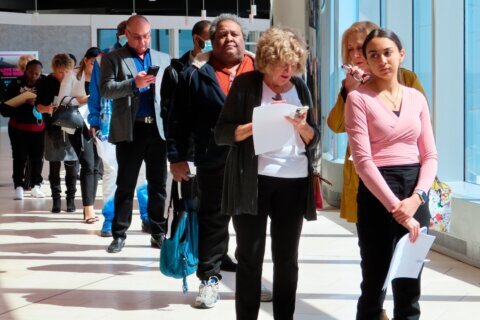The office vacancy rate in D.C. at the end of the first quarter grew to 19.5%, and the vacancy rate has not yet peaked, according to commercial real estate services firm JLL, with companies downsizing or moving out of the city.
But the D.C. office market can still count on nonprofits and associations.
“They are really like the loyal soldiers of the office market,” said Tammy Shoham, research director at JLL in D.C.
Nonprofits are the third-largest source of leasing demand in D.C., behind the federal government and law firms. They are the only sector to maintain the same leasing volume, even during the years through the pandemic, according to JLL.
From 2017 to 2023, growth in nonprofit leasing was stable, at 0.3%. While that doesn’t sound like much, it compares to an 18% shrink in leasing activity in D.C. for all other industries during that same period.
Nonprofits and associations have consistently accounted for 1 million square feet of leasing activity annually, either new leases or renewals, since 2017. It’s the only sector to maintain roughly the same leasing volume.
The high vacancy rate in D.C. and corresponding pressure on landlords to add incentives to fill that space are actually creating more opportunity for nonprofits and associations.
“There is a real desire to be in D.C. partially because of advocacy. Partially because for a lot of nonprofits, the groups that they work with are in the city,” Shoham said. “Now is an opportunity for many of the nonprofits who might have been in outer markets to move into the city because they can find spaces that maybe they couldn’t afford before,”
JLL said 72% of space leased by nonprofits in the D.C. metro is in the District.
There are 13,460 nonprofits and associations registered with headquarters in D.C., and it has more associations than any other city.
The kind of office space they lease differs. Associations tend to prefer flashy, Class A office space. Nonprofits tend to prefer a lower profile, more likely to be occupying Class B office space.
“They don’t really want to be spending money on opulent real estate. It’s not a good look for their board,” Shoham said. “Whereas an association, their executive board is coming from the highest levels of corporations and government. So they are much more willing to have nicer office space.”
Since 2021, 70% of association leases have been in Trophy and Class A buildings, and 79% of nonprofit leases have been in Class B or Class C buildings.
Associations tend to lease larger office space, and want amenities that meet their needs for on-site events.
Nonprofits and associations in D.C. also tend to relocate when signing a new lease. Since 2021, 70% of leases signed by nonprofits in D.C. were relocations, a higher rate than any other industry,
They are also the second-largest occupiers in D.C.’s relatively new waterfront districts, at the Capital Riverfront in Southeast and The Wharf in Southwest. Notable relocations include the Freedom Forum, which moved from Capitol Hill, PhRMA, which moved from the East End to The Wharf, as well as World Shipping Council, Clean Air Task Force and D.C. Central Kitchen, which have moved to Capitol Riverfront in the last two years.
The ballpark area is also home to the National Association of Broadcasters, American Trucking Association and Pyxera Global.
The most recent confirmation of the gravitational pull of the nonprofit industry in D.C. was Atlanta-based Kellen Co.’s announcement that the firm will relocate its corporate headquarters to D.C., doubling its leased space at the National Press Club building. Kellen Co. is one of the largest providers of management and services to trade groups, associations and professional organizations.
Get breaking news and daily headlines delivered to your email inbox by signing up here.
© 2024 WTOP. All Rights Reserved. This website is not intended for users located within the European Economic Area.








